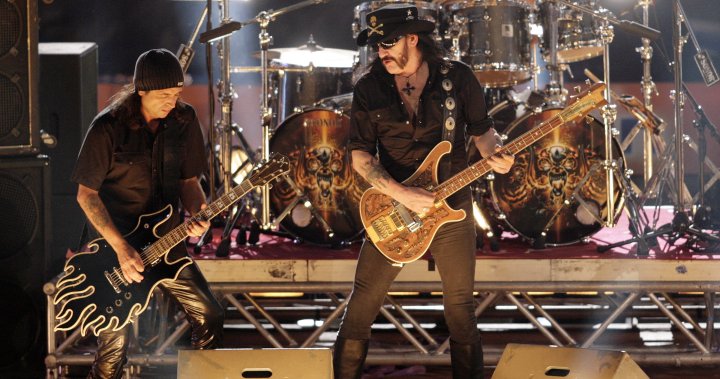On the last Wednesday in August, the good citizens of Buñol, Spain, gather in the main square to throw tomatoes at each other. No one is entirely sure why, either. All most people care about is that it’s fun to pelt friends and strangers with tomatoes, so the La Tomatina Festival became an annual thing. (For the record, it seems to date back to about 1945, when there was some kind of brawl that devolved into the throwing of fruits and vegetables.)
Speaking of throwing things: In Denmark, single people aged 25 are doused with cinnamon by friends and family on Valentine’s Day. No one knows why other than it’s always been a thing. Same thing with tossing newborn babies off the 50-foot Sri Saneswar Temple in India. The tykes are caught by people holding a big cloth below. It’s just tradition, the origins and purposes of which have disappeared into history.
Rock music has been around long enough to have its own inexplicable traditions and behaviours. Let’s look at a few.
Holding lighters aloft at concerts
We’ve all been to a show where at some point people hold lighters (and now cellphones) in the air during the gig. Where did that come from?
The answer goes back to the Toronto Rock’n’Roll Revival, a one-day concert held at Varsity Stadium in Toronto on Sept. 13, 1969. John Lennon was a last-minute addition to the lineup, impetuously deciding to play his first-ever show outside The Beatles. Lennon was nervous to the point of being sick, so MC Kim Fowley urged the crowd to create a cool and peaceful vibe by bringing out their matches and lighters to turn the stadium into a blissful candlelit landscape.
It worked. Lennon came out, played his set with Yoko and the Plastic Ono Band, and went back to the U.K. to announce he was done with The Beatles. We’ve been bringing forth fire (or at least light) at shows ever since.
The “Freebird!” Guy
Chances are you’ve been to some show where someone insists on yelling “Freebird!” as a highly inappropriate request at a non-Lynyrd Skynyrd show. Why?
More on Entertainment
Blame Kevin Matthews, a Chicago radio DJ who had a running bit where he’d encourage his listeners — known as Kevheads — to yell “Freebird” at any concert, no matter who was onstage. And so it began. The Chicago Symphony, Florence Henderson (the mom from The Brady Bunch) and Jim Nabors all had to endure the demands thanks to Kevheads. You can still hear these calls today virtually anywhere, be it at a performance of Mamma Mia or even at a hockey game.
Umlaut bands
You know the kind: Mötley Crüe, Queensrÿche and, of course, Motörhead. “Rock dots,” as they’re sometimes known, are Swedish and German in origin and technically known as a “diacritic,” which is a type of accent. Why would anyone use them? Because they look cool, foreign, Gothic and exotic.
As far as we know, the first band to use umlauts/rock dots in this way was Blue Öyster Cult for no purpose other than it seemed like fun. They may have been inspired by Amon Düül, a psychedelic band from the ’60s who were, in fact, very German. We can also include the American hardcore band Hüsker Dü — except that they use umlauts correctly. “Hüsker Dü” is actually Swedish for “Do you remember?”
Long hair for male rock fans
Long hair on men has gone in and out of style over the centuries and was sometimes the target of scorn. In 1842, The London Saturday Journal wrote: “Many vagrants are musicians, but it does not follow that all musicians are vagrants. It is expected of musicians nowadays to wear long hair as an appendage to their talent.” A long screed against long hair followed.
Fast-forward to the 1930s, 1940s and 1950s, when short hair was culturally enforced. White men who didn’t keep things trim were considered everything from effeminate to subversive to unhygienic. But then along came rock ‘n’ roll in the 1950s and its rebellious attitudes, expressions of personal freedom and new fashion styles. Long hair signalled a man’s membership in the new counterculture, societal pushback be damned.
After The Beatles and their moptops, tresses on men began flowing longer and longer. This continued until the punk backlash of the middle 1970s when long hair was considered an outmoded hippie attribute. Still, long (or at least longish) hair on men continues today, even if that means such unfortunate styles as the mullet.
Headbanging
Any metal show features members of their audience violently shaking their heads in time with the music. How did that become a thing?
This is not a new thing. If we go way back into music history, a similar activity was associated with Islamic music in the Sufi tradition. Qawwali music from India, Pakistan and Iran has also employed headbanging-like movements. Both can be traced back centuries and are related to worshippers falling into trance-like states.
Modern headbanging might have begun with Jerry Lee Lewis and his habit of flicking the curls off his face as he pounded on his piano. It became something of a signature move so fans began to imitate him.
Maybe we can point to a 1969 North American tour by Led Zeppelin where fans — specifically punters at some shows in Boston over several nights that January — were seen banging their heads on the stage in time with the music.
Moving deeper into the 1970s, the same behaviour was seen at Black Sabbath shows, AC/DC gigs and Motörhead performances. In fact, Lemmy liked to take credit for the term itself, saying that it was derived from the sight of people “Motörheadbanging” at their concerts.
Stage diving
There are two types of stage diving. The first is when a performer leaps off the stage into the crowd. The second is when a member of the audience clambers up onstage and dives back into the crowd. Let’s begin with the former.
The first rock performer to jump into the crowd might have been Jim Morrison of The Doors, who is reported to have gone airborne from the stage between 1967 and 1969. The first truly documented stage diver has to be Iggy Pop, who was making it a regular practice during shows with The Stooges by 1969.
As for audience members getting into the act, the first documented crowd participating in stage diving dates back to Aug. 8, 1964, when fans were jumping off the stage at a Rolling Stones show in the Netherlands. That’s so long ago that no one was calling it “stage diving” yet.
Finally, an unsolved mystery: The special audience participation lyrics with Billy Idol’s Version of Mony Mony
I can’t repeat them here, but whenever someone plays Billy Idol’s rendition of Tommy James’ Mony Mony, the crowd will erupt with a profane chant that continues regularly throughout the song. There are slight differences in the chant based on geography (Ontario is different from Colorado, which is different from Texas, which is separate from what they chanted in the U.K.) but no one has ever worked it out. I’ve done some serious study into this pre-internet meme but I’ve never been able to find an explanation of where it came from or how it spread around the globe. I’ve even put the question to Idol himself and he claims to have no idea.
Any other questions?
—
Alan Cross is a broadcaster with Q107 and 102.1 the Edge and a commentator for Global News.
Subscribe to Alan’s Ongoing History of New Music Podcast now on Apple Podcast or Google Play



